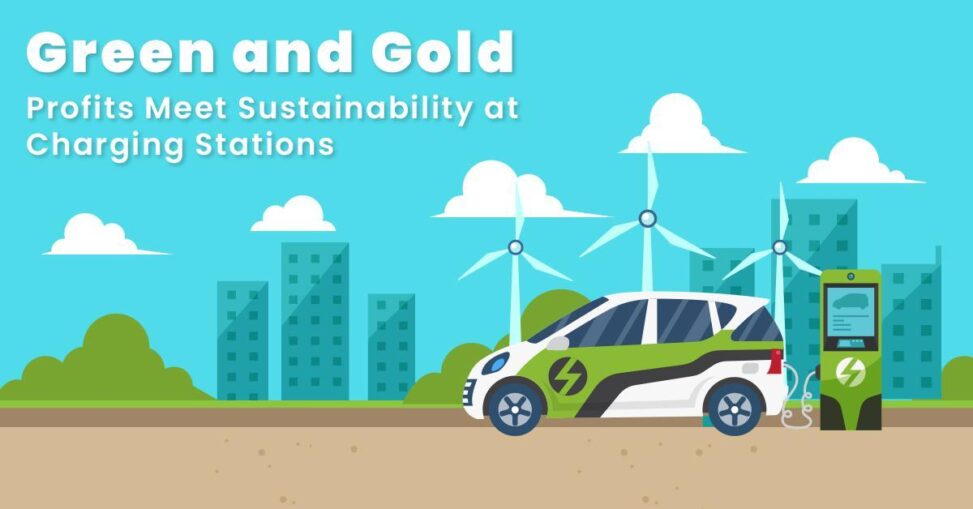The transportation sector is rapidly evolving as electric vehicles become more mainstream. Many countries have set aggressive targets to phase out new internal combustion engine vehicle sales over the next 10-20 years. This major shift brings immense opportunities and challenges for businesses looking to get ahead of the curve.
Investing in electric vehicle (EV) charging infrastructure can be a smart strategic move for companies in relevant industries like energy, real estate, retail, and automotive. However, these investments must be made thoughtfully, with an eye toward sustainability and profitability.
Why Invest in EV Charging Stations?
The time is perfect to start an EV charging station business since there are more chances to succeed as an early starter in the EV industry. All this also depends on the several compelling reasons for businesses to invest in EV charging stations:
Meeting Sustainability Goals
Installing EV chargers clearly demonstrates a commitment to environmental sustainability. With transportation being a major contributor to greenhouse gas emissions, supporting the transition to EVs is an impactful way to reduce a company’s carbon footprint. This helps meet internal sustainability targets and can improve public perception.
Future-Proofing Assets
New research from Wood Mackenzie predicts that Electric vehicle (EV) sales will hit an annual mark of 45 million units by 2040, and total global EV stock will amount to about 323 million. Prudent companies will future-proof assets now to accommodate this shift. Installing charging infrastructure prepares properties and facilities for the upcoming influx of EVs.
Attracting Customers
Providing EV charging access attracts environmentally conscious consumers. Retailers, restaurants, hotels, and other businesses can drive customer visits by marketing themselves as an EV-friendly destination. High-speed chargers along major travel routes are especially appealing.
Competitive Differentiation
Leading the industry on EV infrastructure can be a key competitive advantage. Companies that install chargers early often gain reputation benefits and invaluable customer data. They also avoid losing market share down the road when EVs become standard.
Revenue Generation
Many chargers allow companies to charge usage fees, creating a new revenue stream. The right pricing models and charging speeds can make stations highly profitable. Private networks can be quite lucrative.
Regulatory/Policy Incentives
Numerous government incentives, like tax credits and rebates, exist to spur EV infrastructure investment. Local policies around building codes and zoning can also incentivize charger deployment. Staying on top of these programs can offset costs.
Key Considerations for Profitability
While the benefits are clear, simply installing a few EV chargers here and there is unlikely to be an effective strategy. Companies seeking to grow EV infrastructure profitably should carefully assess:
Optimal Locations
Site selection is critical – the best locations balance accessibility, land availability, electrical capacity, and real estate costs. Analyze traffic patterns, commute routes, and customer data to identify ideal sites.
Local Demand
Market research and examine regional EV registration data to gauge current and projected demand. A higher local EV penetration warrants more investment. Also, consider nearby amenities and dwell time.
Charging Speeds
Faster chargers (100+ kW) provide convenience and maximize utilization but have much higher cap-ex. Balance what users need with equipment costs.
Machine Usage Rates
Monitor usage closely across sites to identify poorly performing stations early. Optimize pricing to incentivize turnover when possible.
Operating Costs
Factor in ongoing costs for maintenance, fees, and electricity. Negotiate favorable utility rates. Labor expenses should also be minimized via smart monitoring and automation.
Revenue Models
Pick the right revenue model based on customer demographics, station formats, and local regulations. Consider hourly vs. per kWh rates, membership plans, advertising, etc. Price competitively but profitably.
Future Expansion Ability
Build extra electrical capacity and reservable land to upgrade/expand stations as demand increases smoothly. This avoids costly retrofitting.
Also, to further aid drivers in finding charging stations, developing a locator app can be a wise investment. The cost to build an EV charging station locator app can vary greatly based on the desired features and functionality. A basic locator app with a map of nearby stations may only cost starts from $25,000 and goes beyond based on the integrations and additional requirements.
However, a more robust app with turn-by-turn navigation, real-time availability checking, and premium features like reservation systems could run over $100,000 for initial development and ongoing maintenance.
Companies should carefully weigh the benefits of an app against the costs and start with an MVP version before adding more extensive capabilities. Properly researching developer costs and appropriately scoping features will help balance value and profitability.
Key Sustainability Considerations
Installing EV chargers makes a positive sustainability impact, but additional steps can boost this further:
Renewable Energy Usage
Use solar energy canopies or source charging station electricity from renewable utility plans. This dramatically lowers carbon emissions compared to fossil fuel-based grids.
Materials Selection
Building an EV charging station sustainably requires thoughtful material choices. Use recycled metals, low-carbon concrete, and responsibly sourced composites to minimize environmental footprints.
Efficient Equipment
Seek out energy-efficient EV charging equipment to lower electricity usage. Smart energy management technology also helps optimize renewable energy usage. Prioritize safety and durability as well.
Land & Site Impacts
Be mindful of local ecology and habitats. When possible, use existing developed land rather than clearing new spaces. Integrate stations into landscapes sustainably via native plantings.
Construction Practices
Use low-impact construction techniques to minimize land disruption. Employ locally sourced materials whenever possible. Avoid unnecessary waste generation through careful planning.
Ongoing Operations
Keep stations running smoothly via eco-friendly operations and maintenance. Use green cleaning supplies and establish recycling practices. Seek sustainability certifications.
Closing Thoughts on EV Charging Station Sustainability & Profitability
The transition to electric transportation brings immense opportunities for forward-thinking companies to deploy profitable EV charging infrastructure that accelerates sustainability.
Businesses can find the ideal balance between economic success and environmental stewardship by carefully researching local markets, optimizing site selection and equipment, and incorporating broader sustainability principles.
Those who strategically invest now will reap the benefits down the road as EVs become the new normal. With a sound strategy grounded in profitability and sustainability, EV charging stations can be a win-win for companies and communities.



